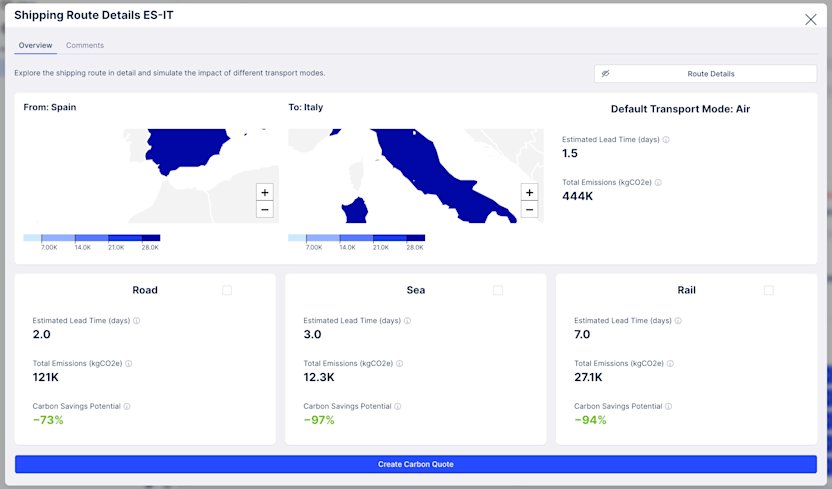
Building a product to reduce emissions with every process step
Companies are struggling to reach their environmental goals. Why? One word: Complexity. Tracking processes that affect carbon emissions is not an easy task. They run across a multitude of systems and are scattered, error-prone and non-transparent. Companies can’t see what is going on in their supply chain. They are causing emissions with every process step but do not understand why, where, and how. These hidden process inefficiencies are killing enterprise's performance - and the planet.
Why shipping emissions?
The transport sector contributes to around a quarter of global greenhouse gas emissions. Freight transport, the transportation of goods and commodities, is the largest contributor. These transport emissions are part of Scope 3 emission which represents a massive chunk of a company's total emissions and is also the most challenging to quantify and reduce.
To achieve net zero and reach the 1.5C Paris climate goals, we need to tackle this problem strategically.

Source: Pexels.com
A recent IBM study found that more than half of Chief Supply Chain Officers would sacrifice profit for sustainability. However, a high-performing company today can no longer simply be efficient - it must also be sustainable. Carbon emissions are becoming an increasingly important metric in this respect.
As a product manager in the sustainability team, I realized that our customers optimizing their order-to-cash-process were asking for solutions to also reduce emissions. They want to go beyond optimizing lead times and delivery costs. And they also get requests from their sustainability teams to help them get the data to calculate shipping emissions.
But it’s challenging. I have spoken to many companies and found that most of them have similar problems, which include:
Siloed data: It’s hard to collect and integrate data between companies, suppliers, and carriers. It is not a secret that currently most companies are still using Excel and manual calculations to quantify their emissions.
No single source of truth: Unlike financial data that is widely available in a company ERP, carbon emissions data is not readily available across the business. Let alone in logistics operations.
Difficulties to create action: Although all companies know that they want to reduce emissions, it is hard to identify the root causes and implement reduction measures in their logistics.
How Celonis helps to reduce shipping emissions
At Celonis, finding inefficiencies and taking action to improve them, is our bread and butter. We start by listening to our customer's pain points and dissecting them to the smallest detail.
In developing the right solution to reduce shipping emissions, we have conducted co-innovation projects with many customers, including BSH Home Appliances, Delphi Technologies and the LEGO Group. In addition, we have brought on board Climatiq, a partner with outstanding expertise in the creation of intelligent climate solutions based on scientific data.
Let me introduce you to our Shipping Emissions Reduction app. It is built on top of our Execution Management System with a sole focus to help companies reduce their shipping emissions. Our app will help customers to map and monitor their transport emissions in real-time, identify areas for improvement, and take corrective action to reduce their carbon footprint.
How? Let me provide you with an example: It's not a big secret that a high air freight rate is one of the biggest drivers of transportation emissions. With our solution, it is possible to drill down into the different process steps and identify which inefficiencies are increasing air freight. In addition, the app intelligently suggests where you can switch transportation modes and go from air to road, considering the impact of that on cost and time as well.
There are 3 main values that we provide within the app:
Data: The app is automatically combining logistic data from ERP systems with emission data by using the state-of-the-art carbon engine API from our partner Climatiq. With this, we make sure that the shipping emissions are calculated based on industry standards such as GLEC (Global Logistics Emissions Council). This saves our users many hours of tedious manual compilation and validation of numerous Excel files. It gives them the opportunity to see the impact of process inefficiencies, not only towards cost and time, but also on carbon emissions.
Simulation: Our solution does not only provide backward-looking data to understand what has happened. We also provide forward-looking capabilities. The app simulates emissions impact for different modes of transport. For example, comparing the emission impact of using air freight compared to sea transport. A logistics manager can proactively select the method of transport and route to deliver the products in the most carbon-optimal way.
Recommendation: The app is also capable of providing recommended actions for carbon-saving opportunities. With the quantified carbon-saving potentials. For example, avoiding rush orders to minimize air freight or bundling orders to increase truck utilization. An operations manager can use these insights to take action and include carbon emissions in the decision-making process.
These features were developed based on real-world use cases that we learned through the co-innovation programs with our customers.

Illustration of transport mode simulation feature.
Arindam Basu, Senior Sustainability Manager at the LEGO Group, mentioned “Identifying all inefficiencies in our business execution and how they may lead to carbon emissions as well as calculating where there is further carbon-saving potential is critical for us and the opportunity to partner with companies like Celonis can be an important step in that direction.”
Conclusion: the app helps our customers to reduce shipping emissions
At Celonis, one of our company values is “Earth is our Future”. The future of our Earth can’t be solved with legacy systems; we need a new way to tackle emissions in shipping operations.
Becoming more sustainable does not mean higher costs and slower results. With our shipping emissions reduction app, companies can now include carbon emissions as an operational KPI and achieve their ambitious sustainability targets.
We recently launched our app at Celosphere in limited availability. If you are interested, contact me here and I will be happy to show you a demo.
“On-time delivery is now also on point with the environment”.






